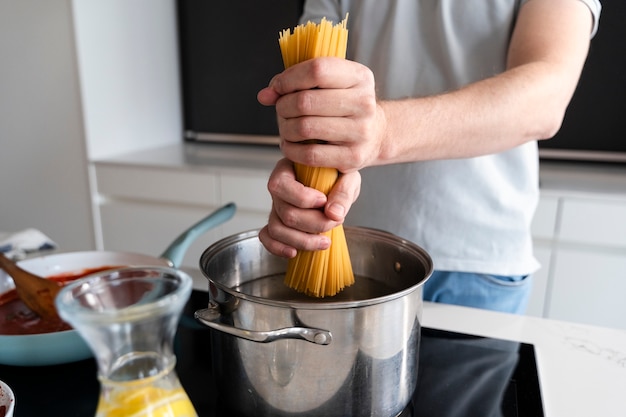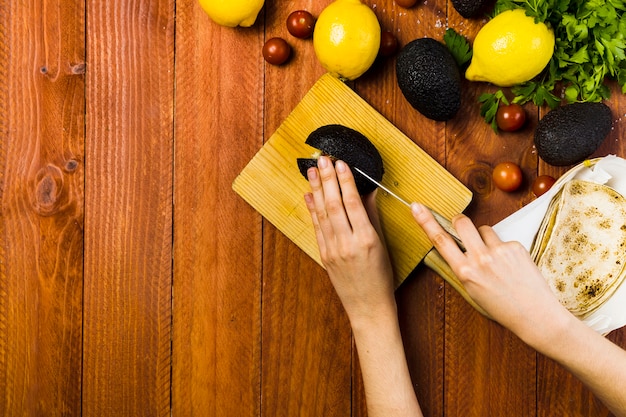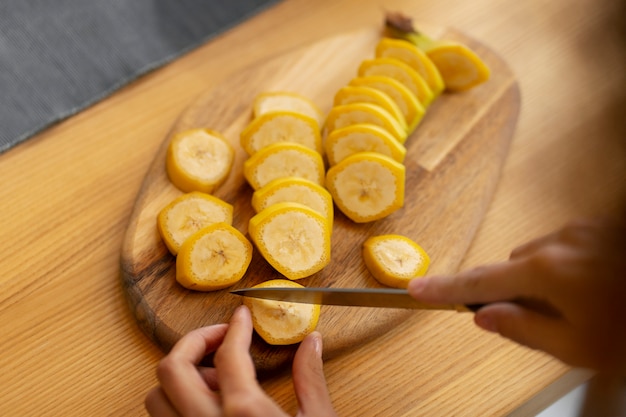You've got a spaghetti squash in your hands and you're wondering how to cook it. Don't worry, you've come to the right place! This isn't your average butternut squash; it needs a bit of extra attention to get that delightful, stringy texture.
I've been cooking with spaghetti squash for years, and let me tell you, it's been quite a journey. I've had my fair share of overcooked, mushy squash, and on the flip side, some that were still rock-hard in the middle. But through trial and error (and a lot of experimentation!), I've finally cracked the code to getting that perfect, al dente squash every time.
So, grab your trusty baking sheet and a sharp knife, and get ready to learn everything you need to know about cooking spaghetti squash to perfection!
(Part 1) Picking the Right Squash: It All Starts with a Good Squash

What to Look For
The first step is choosing the right spaghetti squash. You want one that feels heavy for its size, which means it's packed with flavour.
- The skin should be firm and smooth, with no bruises or soft spots.
- Avoid any squash with cracks or cuts, as these can harbour bacteria.
When it comes to size, if you're just cooking for yourself or a small family, a smaller squash will do the trick. But if you're feeding a crowd, go for a bigger one. I've found that a medium-sized squash (about 2-3 pounds) is a good starting point for most people.
Storing Your Squash
Once you've got your perfect squash, it's important to store it properly. Keep it at room temperature in a cool, dry place for up to a week. You can also store it in the refrigerator for up to two weeks.
(Part 2) Preparing the Squash: It's Time to Get Cutting

Cutting the Squash
Now, it's time to get your hands dirty (and maybe a few cutting boards, too!). The first step is cutting the squash in half. I find that a sturdy chef's knife is the best tool for the job.
- Start by slicing the squash in half lengthwise, right through the middle.
- If you're using a smaller squash, you might be able to cut through it with one go. For larger ones, you might need to make a couple of cuts.
Once you've got the squash in half, it's time to scoop out the seeds and pulp. This is easier than it looks – just grab a spoon and scoop out all that gooey stuff.
Scooping Out the Seeds
- Make sure you get all the seeds out, or you'll end up with a bitter taste in your final dish.
- You can save the seeds for later – they can be roasted and eaten as a snack or used to make a pesto.
(Part 3) Cooking Your Squash: The Main Event

oven method
Now, for the big reveal – the cooking methods! The most popular and easiest method is the oven. Here's what you need to do:
- Preheat your oven to 375°F (190°C).
- Place the squash halves, cut-side down, on a baking sheet.
- You can add a little water to the baking sheet to prevent the squash from drying out.
- Bake for 45-60 minutes, or until the squash is tender and easily pierced with a fork.
How to Know When It's Done:
To test if your squash is ready, simply pierce the flesh with a fork. If the fork goes in easily, it's done!
Microwave Method
For a faster option, you can cook your spaghetti squash in the microwave. This is a great option if you're short on time.
- Pierce the skin of the whole squash several times with a fork to prevent it from exploding in the microwave.
- Microwave on high for 8-10 minutes, or until tender.
The microwave method is definitely quicker, but it might not be as consistent as the oven method, especially if you have a large squash.
Other Cooking Methods
There are also other cooking methods for spaghetti squash, such as steaming or pressure cooking. However, I find that the oven or microwave methods are the simplest and most reliable.
(Part 4) The Final Touch: Fluffing and Serving
Fluffing the Squash
Once your squash is cooked, let it cool for a few minutes before you try to handle it – it'll be hot!
- When it's cool enough to touch, use a fork to scrape the flesh away from the skin.
- The flesh will separate into long, stringy strands that resemble spaghetti, hence the name.
Serving Ideas
Now, for the fun part – serving it! Spaghetti squash is incredibly versatile.
- It's delicious served simply with a bit of olive oil, salt, and pepper.
- You can also mix it with your favourite sauces, like marinara, pesto, or alfredo sauce.
- It's also great in salads, soups, and stews.
- Get creative! Try it with a sprinkle of herbs, a squeeze of lemon juice, or a dollop of ricotta cheese.
(Part 5) The Spaghetti Squash Debate: To Salt or Not to Salt?
This is a question I get asked a lot, and it's a matter of personal preference. Some people swear by adding salt to the water before cooking their spaghetti squash, claiming it helps to retain moisture and enhance flavour.
I personally don't add salt during the cooking process – I find that it can make the squash a bit salty, especially if you're not using it all right away. I prefer to season my squash with salt and pepper after it's cooked.
(Part 6) spaghetti squash nutrition: A Healthy Choice
Spaghetti squash is a good source of vitamins and minerals, including vitamin C, potassium, and folate. It's also a good source of fibre and a low-calorie food.
Here's a table outlining some of the key nutritional benefits of spaghetti squash per 100g:
| Nutrient | Amount |
|---|---|
| Calories | 26 |
| Vitamin C | 10mg |
| Potassium | 230mg |
| Folate | 20mcg |
| Fiber | 2g |
This makes it a great choice for those looking for a healthy and delicious meal option.
(Part 7) Troubleshooting: What if It's Not Cooking Right?
The Squash Isn't Tender
If your spaghetti squash isn't tender enough after 60 minutes in the oven, it might need a little more time. Check it every 10 minutes or so until it's cooked through.
The Squash Is Overcooked and Mushy
If your spaghetti squash is overcooked and mushy, it's likely because you left it in the oven too long. You can try to salvage it by scraping off the mushy parts and using the rest. But if it's too far gone, it's best to start over.
(Part 8) Spaghetti Squash: A Recipe for Success
Here's a simple recipe for spaghetti squash that's perfect for a weeknight dinner:
baked spaghetti squash with Garlic and Parmesan
Ingredients:
- 1 medium spaghetti squash
- 2 tablespoons olive oil
- 2 cloves garlic, minced
- 1/4 cup grated Parmesan cheese
- Salt and pepper to taste
Instructions:
- Preheat your oven to 375°F (190°C).
- Cut the squash in half lengthwise and scoop out the seeds.
- Place the squash halves, cut-side down, on a baking sheet.
- Bake for 45-60 minutes, or until tender.
- Let the squash cool for a few minutes before scraping the flesh away from the skin with a fork.
- In a small skillet, heat the olive oil over medium heat. Add the garlic and cook for 1 minute, or until fragrant.
- Pour the garlic oil over the spaghetti squash and toss to coat.
- Sprinkle with Parmesan cheese and season with salt and pepper to taste.
(Part 9) spaghetti squash variations: Beyond the Basics
Spaghetti squash doesn't have to be just a simple side dish. It's versatile enough to be the star of the show in many dishes. Here are some ideas to get your creative juices flowing:
Savoury Dishes
- Spaghetti Squash Carbonara: Mix cooked spaghetti squash with pancetta, eggs, and Parmesan cheese for a hearty and satisfying meal.
- Spaghetti Squash Lasagna: Layer cooked squash with your favourite lasagna fillings for a lighter version of the classic dish.
- Stuffed Spaghetti Squash: Fill the hollowed-out squash halves with a mixture of ground meat, vegetables, and cheese for a delicious and impressive main course.
Sweet Dishes
- Spaghetti Squash Dessert: Toss cooked spaghetti squash with cinnamon, nutmeg, and brown sugar for a unique and healthy dessert.
- Spaghetti Squash Bread Pudding: Combine cooked squash with bread, eggs, milk, and spices for a comforting and flavourful dish.
(Part 10) FAQs: Your Burning Spaghetti Squash Questions Answered
Here are some frequently asked questions about spaghetti squash:
Q1: What can I do with the seeds?
The seeds of spaghetti squash are edible and can be roasted or used to make a pesto. To roast them, toss them with olive oil, salt, and pepper and bake at 350°F (175°C) for 15-20 minutes, or until golden brown.
Q2: Can I freeze spaghetti squash?
Yes, you can freeze spaghetti squash. To freeze it, simply cook the squash as usual and then scoop out the flesh. Place it in a freezer-safe container or bag and freeze for up to 3 months.
Q3: How long does it take to cook spaghetti squash in a pressure cooker?
It takes about 5-7 minutes to cook spaghetti squash in a pressure cooker.
Q4: Can I cook spaghetti squash in the instant pot?
Yes, you can cook spaghetti squash in the Instant Pot. Simply add the squash halves, cut-side down, to the Instant Pot and cook on high pressure for 6-8 minutes. Let the pressure release naturally for 10 minutes before releasing the remaining pressure manually.
Q5: What's the best way to store cooked spaghetti squash?
Cooked spaghetti squash can be stored in the refrigerator for up to 3 days. To store it, place the squash in an airtight container or wrap it tightly in plastic wrap.
So there you have it, everything you need to know about cooking spaghetti squash. From picking the right squash to serving it up, I hope this guide has helped you understand how to cook this versatile vegetable to perfection.
Happy cooking!
Everyone is watching

How to Cook Frozen Lobster Tails Perfectly: A Step-by-Step Guide
RecipesLobster. Just the word conjures up images of lavish meals, special occasions, and a taste of luxury. But let's...

Pigs in a Blanket Cooking Time: How Long to Bake for Perfect Results
RecipesAh, pigs in a blanket. Just the name conjures up images of those delightful little parcels of crispy pastry en...

Pork Fillet Cooking Time: How Long to Cook It Perfectly
RecipesPork fillet, or tenderloin as it's sometimes called, is a real favourite in our house. It's so versatile, and...

The Ultimate Guide to Cooking Delicious Frankfurters
RecipesLet's face it, we all love a good frankfurter. It's a classic, simple, and always satisfying. But let's be rea...

Wolf Meat Recipes: A Guide to Cooking Wild Game
RecipesLet's be honest, you don't see wolf meat at your local butcher shop every day. It's a bit of a wild card, but ...
